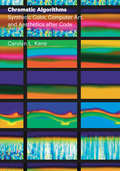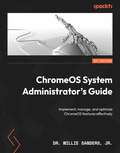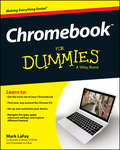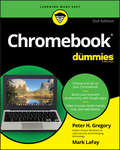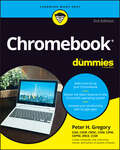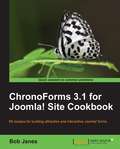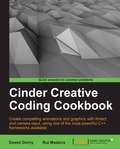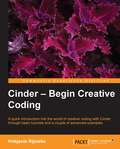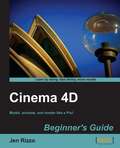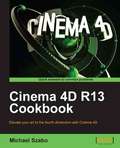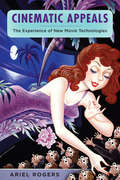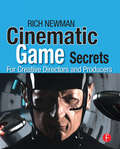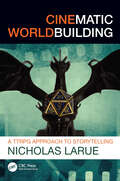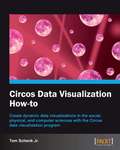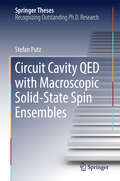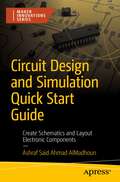- Table View
- List View
Chrissa
by Mary CasanovaChrissa Maxwell moves to a new school in the middle of the year, and the girls in her fourth-grade class are decidedly unfriendly. On the advice of her grandmother, Chrissa tries first to be nice, and then to ignore the mean girls. But they just won't quit, and when the teasing turns into serious bullying, Chrissa must find the courage to stand strong and speak out.
Chromatic Algorithms: Synthetic Color, Computer Art, and Aesthetics after Code
by Carolyn L. KaneThese days, we take for granted that our computer screens--and even our phones--will show us images in vibrant full color. Digital color is a fundamental part of how we use our devices, but we never give a thought to how it is produced or how it came about. Chromatic Algorithms reveals the fascinating history behind digital color, tracing it from the work of a few brilliant computer scientists and experimentally minded artists in the late 1960s and early '70s through to its appearance in commercial software in the early 1990s. Mixing philosophy of technology, aesthetics, and media analysis, Carolyn Kane shows how revolutionary the earliest computer-generated colors were--built with the massive postwar number-crunching machines, these first examples of "computer art” were so fantastic that artists and computer scientists regarded them as psychedelic, even revolutionary, harbingers of a better future for humans and machines. But, Kane shows, the explosive growth of personal computing and its accompanying need for off-the-shelf software led to standardization and the gradual closing of the experimental field in which computer artists had thrived. Even so, the gap between the bright, bold presence of color onscreen and the increasing abstraction of its underlying code continues to lure artists and designers from a wide range of fields, and Kane draws on their work to pose fascinating questions about the relationships among art, code, science, and media in the twenty-first century.
ChromeOS System Administrator's Guide: Implement, manage, and optimize ChromeOS features effectively
by Dr. Willie SandersExplore the sysadmin features and architecture of ChromeOS to master its local and cloud-based administrative tools and capabilitiesKey FeaturesGet a complete overview of using ChromeOS as a powerful system admin toolGet hands-on experience working with Google's administration platformLearn about centralized management of resources as the hallmark of enterprise system administrationBook DescriptionGoogle's ChromeOS provides a great platform for technicians, system administrators, developers, and casual users alike, providing a seemingly simplistic architecture that is easy enough for a novice user to begin working with. However, beneath the surface, this operating system boasts a plethora of powerful tools, able to rival any other OS on the market. So, learning how to harness the full potential of the OS is critical for you as a technical worker and user to thrive at your workplace. ChromeOS System Administrator's Guide will help you reap the benefits of all features of ChromeOS.This book explains ChromeOS' unique architecture and its built-in tools that perform essential tasks such as managing user accounts, working with data, and launching applications. As you build your foundational knowledge of the OS, you'll be exposed to higher-level concepts such as security, command line, and enterprise management.By the end of this book, you'll be well-equipped to perform a range of system administration tasks within ChromeOS without requiring an alternative operating system, thereby broadening your options as a technician, system administrator, developer, or engineer.What you will learnInstall, update, and configure ChromeOS on standalone devicesManage Google's cloud-based applications and resources effectivelyImplement key networking and security features to protect your architecture from cyber threatsUnderstand common troubleshooting and disaster recovery techniquesMigrate data from other platforms to Google Workspace efficientlyPerform administrative tasks and run Linux scripts with Chrome ShellManage your enterprise from the Google Workspace Admin ConsoleWho this book is forThis book is for you if you want to become a system administrator, developer, or engineer, and are looking to explore ChromeOS architecture all while expanding your knowledge of administration tools and techniques. Basic knowledge of system administration is required.
Chromebook For Dummies
by Mark LafayGet the most out of your Google ChromebookAre you the proud new owner of a Google Chromebook and a little--or a lot--intimidated by the technology? You've come to the right place! Chromebook For Dummies walks you through setting up the device, transitioning from traditional computers and working in the cloud, customizing Chromebook to suit your needs, navigating the apps and their uses, and applying advanced settings and features. Fear not: with the step-by-step guidance and helpful information inside, there's no reason to break a sweat.Chromebooks are affordable, fast, and sleek--and with Google driving the initiative, they're impossible to ignore. So it's no wonder they're gaining popularity and enticing people from all walks of life to make the switch from a traditional PC or laptop. If you're one of those people and want to make the most of your experience, this book is a practical user's guide to all things Chromebook.Covers all Chromebooks on the marketProvides coverage of all Chromebook features in an easy-to-follow mannerServes as the go-to reference for successfully using a ChromebookIncludes step-by-step coverage of everything you'll encounter with your ChromebookIf you're a new or inexperienced user who wants to maximize the performance of your Google Chromebook, you'll turn to this friendly guide time and again.
Chromebook For Dummies
by Peter H. GregoryGet the most out of your Google Chromebook Chromebook For Dummies walks you through setting up your Chromebook, transitioning from traditional computers, customizing a Chromebook to fit your needs, navigating the many apps and their uses, and applying advanced settings and features. This book documents the features of all Chromebooks, approaching them from the point of view of a smart person who is intimidated by the technology. Offers extensive and practical information Covers all portable computers powered by Chrome OS Helps make it easy to drive these fast, user-friendly devices Includes coverage of the latest features in the Chrome operating system You’ll end up keeping this book close at hand, referring to it often as you explore the features of your Chromebook.
Chromebook For Dummies
by Peter H. GregoryThe return of the bestselling Chromebook guide on the market Chromebook For Dummies, Third Edition, is your easy-to-follow guide to the low-cost alternative to a traditional laptop. This beginner’s manual walks you through setting up your Chromebook, transitioning from using a traditional computer, and customizing the system to fit your needs. In case you’re wondering, the Chromebook can be used for anything you'd normally do online—checking email, browsing websites, watching videos. This book takes you through all of it, giving you the latest updates on new Chromebook hardware and software features. Navigate apps, apply advanced settings and features, and turn to this guide time and again as you customize and optimize your Chromebook’s performance. Get all the basics on using your Chromebook, in easy-to-follow Dummies style Set up and start using your Chromebook with ease Learn about the latest features in the Chrome operating system Discover the benefits of Chromebook versus traditional laptopsNew and novice Chromebook users will love this approachable intro to Google’s little portable computer.
Chronicles: Formalization of a Temporal Model (SpringerBriefs in Computer Science)
by Thomas Guyet Philippe BesnardThis book is intended as an introduction to a versatile model for temporal data. It exhibits an original lattice structure on the space of chronicles and proposes new counting approach for multiple occurrences of chronicle occurrences. This book also proposes a new approach for frequent temporal pattern mining using pattern structures. This book was initiated by the work of Ch. Dousson in the 1990’s. At that time, the prominent format was Temporal Constraint Networks for which the article by Richter, Meiri and Pearl is seminal. Chronicles do not conflict with temporal constraint networks, they are closely related. Not only do they share a similar graphical representation, they also have in common a notion of constraints in the timed succession of events. However, chronicles are definitely oriented towards fairly specific tasks in handling temporal data, by making explicit certain aspects of temporal data such as repetitions of an event. The notion of chronicle has been applied both for situation recognition and temporal sequence abstraction. The first challenge benefits from the simple but expressive formalism to specify temporal behavior to match in a temporal sequence. The second challenge aims to abstract a collection of sequences by chronicles with the objective to extract characteristic behaviors. This book targets researchers and students in computer science (from logic to data science). Engineers who would like to develop algorithms based on temporal models will also find this book useful.
Chrono Trigger (Boss Fight Books)
by Michael P. WilliamsWhen Boss Fight Books first gave fans the chance to vote for the game they most wanted to read a book about, they chose the epic time travel RPG Chrono Trigger. Featuring new interviews with translator Ted Woolsey and DS retranslator Tom Slattery, Michael P. Williams's book delves deep into connections between Crono&’s world and ours, including Chrono Trigger's take on institutions such as law and religion, how the game's heroes fit and defy genre conventions, and the maddening logical headaches inherent in any good time travel plot. From the Magus dilemma to the courtroom scene, find out why many consider this game the high point in the entire role-playing genre in this in-depth examination of Chrono Trigger, a ton of fun and a true work of art.
ChronoForms 3.1 for Joomla! site Cookbook
by Bob JanesThis book is the missing manual for creating forms on your Joomla! site. Using simple examples that you can easily follow we will show you how you can create forms of almost any kind. Most of the chapters focus on one topic starting with simple recipes for new users and then adding new features that add more to the form but may also require more knowledge and experience to implement.Other chapters look in more detail at adding special features, or creating forms to perform particular tasks. Again the recipes range from those that a new user can easily implement to those that will help more advanced developers.Each recipe is kept as simple as possible and set out so that it can be easily implemented with the code supplied; and the recipes are also a set of building blocks that you can use to create much more complex forms using several recipes to build your form.As far as space allows we have explained how the code works, what features of Joomla or of ChronoForms we are using and we've offered suggestions in the 'There's more . . .' sections for ways in which the basic recipe can be extended or adapted.The code examples are complete and can be adapted by new users with the minimum of customization or they can be as a starting point for developers with more coding experience to build on and adapt to create fully customized form applications. This is a practical hands-on book for people who want to add forms to their Joomla! site. Whether you just want to add a simple newsletter sign-up form or a complex multi-page interactive form you'll find helpful suggestions and recipes that will get your forms working. Many recipes will work 'out-of-the-box' using ChronoForms built-in capabilities; other more advanced recipes require some knowledge of Joomla!, HTML, CSS ,PHP, MySQL or JavaScript. There is working code with each recipe that you can adapt to meet your specific needs.
Cinder Creative Coding Cookbook
by Rui Madeira Dawid GornyFull of easy-to-follow recipes and images that will teach powerful techniques and algorithms, building from basic projects to challenging applications. This book is for artists, designers, and programmers who have previous knowledge of C++, but not necessarily of Cinder.
Cinder – Begin Creative Coding
by Krisjanis RijnieksPresented in an easy to follow, tutorial-style format, this book will lead you step-by-step through the multi-faceted uses of Cinder."Cinder: Begin Creative Coding" is for people who already have experience in programming. It can serve as a transition from a previous background in Processing, Java in general, JavaScript, openFrameworks, C++ in general or ActionScript to the framework covered in this book, namely Cinder. If you like quick and easy to follow tutorials that will let yousee progress in less than an hour - this book is for you. If you are searching for a book that will explain algorithms for complex 2D and 3D generative animations and use of advanced C++ and / or Open GL features - it is not.
Cinema 4D 11 Workshop
by Arndt von KoenigsmarckModel, texture and animate with Cinema 4D 11 using the techniques and tips provided in Cinema 4D 11 Workshop. Starting with all of the basic concepts, functions, and tools - follow along to the workshop tutorials that deliver a hands-on knowledge of the new R11 toolset as well as the returning advanced features. The companion website provides all of the required tutorial media from the projects in the book so that you create your own working models and animations.
Cinema 4D Beginner's Guide
by Jen RizzoStep-by-step instructions with guiding screenshots will help new users to create a photorealistic interior scene with an animated camera. Users will also learn how to use the MoGraph module to create dynamic motion graphics, how to link parameters with Xpresso (Cinema 4D's node-based programming language), and are guided through mini-projects to explore additional tools for non-photorealistic illustrations, hair creation and cloth rendering. Designers and artists with a basic proficiency in animation or computer graphics, as well as professionals who are familiar with other 3D animation software.
Cinema 4D R13 Cookbook
by Michael SzaboThis book contains short recipes designed to effectively teach tools in the minimum amount of time. Each recipe hits on a topic that can be combined or incorporated with other recipes to give you the building blocks you need to start making great designs with Cinema 4D. Rather than demonstrating how to make a few specific and extensive projects, the recipes create a solid base of knowledge to help the reader understand the tools available to foster their own creativity. This book is for anyone who wants to quickly get up to speed with Cinema 4D to create 3D projects that run laps around simple 2D designs.
Cinema 4D R14 Cookbook
by Michael Szabo Simon RussellThis book is written in a Cookbook style with short recipes designed to effectively teach tools in the minimum amount of time. Each recipe hits on a topic that can be combined or incorporated with other recipes to give you the building blocks you need to start making great designs with Cinema 4D. Rather than demonstrating how to make a few specific and extensive projects, the recipes create a solid base of knowledge to help the reader understand the tools available to foster their own creativity.This book is for professional artists working in architecture, design, production, or games and wanting to use Cinema 4D to create amazing 3D graphics. It is for anyone who wants to quickly get up to speed with Cinema 4D to create 3D projects that run laps around simple 2D designs.
Cinema Taiwan: Politics, Popularity and State of the Arts
by Darrell William Davis Ru-Shou Robert ChenFollowing the recent success of Taiwanese film directors, such as Hou Hsiao-hsien, Edward Yang, Ang Lee and Tsai Ming-liang, Taiwanese film is raising its profile in contemporary cinema. This collection presents an exciting and ambitious foray into the cultural politics of contemporary Taiwan film that goes beyond the auterist mode, the nation-state argument and vestiges of the New Cinema. Cinema Taiwan considers the complex problems of popularity, conflicts between transnational capital and local practice, non-fiction and independent filmmaking as emerging modes of address, and new possibilities of forging vibrant film cultures embedded in national (identity) politics, gender/sexuality and community activism. Insightful and challenging, the essays in this collection will attract attention to a globally significant field of cultural production and will appeal to readers from the areas of film studies, cultural studies and Chinese culture and society.
Cinematic Algorithms: The Rise of Generative AI in Video Art and Visual Culture
by Andrew Smith James HutsonThis book explores the groundbreaking integration of generative artificial intelligence into filmmaking and visual storytelling. From democratizing video production to reshaping aesthetics, this book highlights the creative revolution AI offers. Through case studies, interviews with innovative artists, and historical perspectives, it examines how intelligent systems enhance creativity while challenging traditional notions of authorship and originality. With practical guides and forward-looking insights, this volume is essential for anyone curious about the intersection of technology and visual culture, offering a vivid portrait of the future of storytelling in an AI-driven world.
Cinematic Appeals: The Experience of New Movie Technologies (Film and Culture Series)
by Ariel RogersCinematic Appeals follows the effect of technological innovation on the cinema experience, specifically the introduction of widescreen and stereoscopic 3D systems in the 1950s, the rise of digital cinema in the 1990s, and the transition to digital 3D since 2005. Widescreen cinema promised to draw the viewer into the world of the screen, enabling larger-than-life close-ups of already larger-than-life actors. This technology fostered the illusion of physically entering a film, enhancing the semblance of realism. Alternatively, the digital era was less concerned with the viewer's physical response and more with information flow, awe, and the reevaluation of spatiality and embodiment. This study ultimately shows how cinematic technology and the human experience shape and respond to each other over time.
Cinematic Game Secrets for Creative Directors and Producers: Inspired Techniques From Industry Legends
by Rich NewmanCinematography for Games covers the space between the game and film industries by pointing out the most relevant cinematic techniques in today's hottest games, and including interviews with the game industry's greatest luminaries (including Will Wright: Sims legend, Harvey Smith, legendary game Deus Ex, Warren Spector creator of one of the original game companies, Origin).The convergence of games and film is a widely discussed and debated topic in the game industry. Many major publishers, along with some high-profile directors (John Woo, James Cameron, Steven Spielberg, Tony Scott) are exploring the middle ground between the industries. This book introduces game producers and directors to the tried and true techniques cinematographers have relied on for years.Game developers learn how to create compelling video games by: developing quality stories and characters; visualizing scenes within the game through the eyes of a cinematographer; using tried and true film industry methods for casting, voice-over, direction, and production.The book will also feature screen shots from some of today's hottest titles that illustrate key cinematic concepts, as well as advice from successful game industry professionals already using these techniques.
Cinematic Worldbuilding: A TTRPG Approach to Storytelling
by Nicholas LaRueEverybody has a story in them. Some people lack the language and the tools to tell that story effectively. As an avid tabletop role-playing game player, I’m amazed at people’s ability to tell stories on the spot. Both the players and the game masters are creating worlds in their minds and playing out the events, using improv, in real-time. Being an author and screenwriter, I know how difficult it is to create consistent and well-constructed characters, themes, and conflicts. I believe that storytellers looking to level up in the classroom, their hobby, or career could learn a lot from games like Dungeons & Dragons, Pathfinder, and others. This book seeks to give people the tools and language to create and master their worlds and characters, using TTRPG mechanics and rulesets as foundational elements. This book will contain insights and interviews from some of today’s most respected game masters, players, actual play actors, and we’ll also hear from some of the people behind the scenes responsible for creating these games, and how they view worldbuilding and storytelling for their audiences.
Circadian Rhythms for Future Resilient Electronic Systems: Accelerated Active Self-Healing for Integrated Circuits
by Xinfei Guo Mircea R. StanThis book describes methods to address wearout/aging degradations in electronic chips and systems, caused by several physical mechanisms at the device level. The authors introduce a novel technique called accelerated active self-healing, which fixes wearout issues by enabling accelerated recovery. Coverage includes recovery theory, experimental results, implementations and applications, across multiple nodes ranging from planar, FD-SOI to FinFET, based on both foundry provided models and predictive models. Presents novel techniques, tested with experiments on real hardware;Discusses circuit and system level wearout recovery implementations, many of these designs are portable and friendly to the standard design flow;Provides circuit-architecture-system infrastructures that enable the accelerated self-healing for future resilient systems;Discusses wearout issues at both transistor and interconnect level, providing solutions that apply to both;Includes coverage of resilient aspects of emerging applications such as IoT.
Circos Data Visualization How-to
by Tom SchenkRecipes that follow a problem-solution approach. It's a friendly, hands-on guide to creating visualizations with step-by-step instructions. This book is targeted at statisticians, analysts, and graphic designers with an interest in data visualization. The author does not presume any experience with Circos and steps through the installation and diagram creation process.
Circuit Cavity QED with Macroscopic Solid-State Spin Ensembles (Springer Theses)
by Stefan PutzThis thesis combines quantum electrical engineering with electron spin resonance, with an emphasis on unraveling emerging collective spin phenomena. The presented experiments, with first demonstrations of the cavity protection effect, spectral hole burning and bistability in microwave photonics, cover new ground in the field of hybrid quantum systems. The thesis starts at a basic level, explaining the nature of collective effects in great detail. It develops the concept of Dicke states spin-by-spin, and introduces it to circuit quantum electrodynamics (QED), applying it to a strongly coupled hybrid quantum system studied in a broad regime of several different scenarios. It also provides experimental demonstrations including strong coupling, Rabi oscillations, nonlinear dynamics, the cavity protection effect, spectral hole burning, amplitude bistability and spin echo spectroscopy.
Circuit Design and Simulation Quick Start Guide: Create Schematics and Layout Electronic Components (Maker Innovations Series)
by Ashraf Said AlMadhounOpen up the exciting world of electronics with 3D circuit designing tools and create your own fresh new projects. With this quick guide you’ll use high-quality graphical programs to create, modify, and update circuits in an interactive, virtual environment that can also be used in the real world. Follow along with the tutorials and get the chance to play with electronics safely before getting your hands dirty. In just a few minutes, you’ll start creating your first circuit. You’ll focus more on how the components layout together than on worrying about design to get started. Watch as different electronic components receive different signals and test them in different situations and circuit conditions first before moving on to real-life testing. When you’re ready, you’ll work with real breadboards and microcontrollers, such as the Arduino, to bring your simulated circuits and projects to life. Once you have your circuit put together, work with basic Arduino programming to give it purpose and make it respond to your commands. By the end of the book you'll have mastered the basics of both circuit design and programming. What You'll LearnEngineer electrical equipment for little to no costMeasure different electrical signals, such as voltage, temperature, light, and moreProgram Arduinos to work with your new circuitsWho This Book Is ForStudents and hobbyists interested in electrical engineering and programming who want to dive into experimentation virtually before working with real-world circuits.
Circuit Design with VHDL
by Volnei A. PedroniThis textbook teaches VHDL using system examples combined with programmable logic and supported by laboratory exercises. While other textbooks concentrate only on language features, Circuit Design with VHDL offers a fully integrated presentation of VHDL and design concepts by including a large number of complete design examples, illustrative circuit diagrams, a review of fundamental design concepts, fully explained solutions, and simulation results. The text presents the information concisely yet completely, discussing in detail all indispensable features of the VHDL synthesis. The book is organized in a clear progression, with the first part covering the circuit level, treating foundations of VHDL and fundamental coding, and the second part covering the system level (units that might be located in a library for code sharing, reuse, and partitioning), expanding upon the earlier chapters to discuss system coding.

